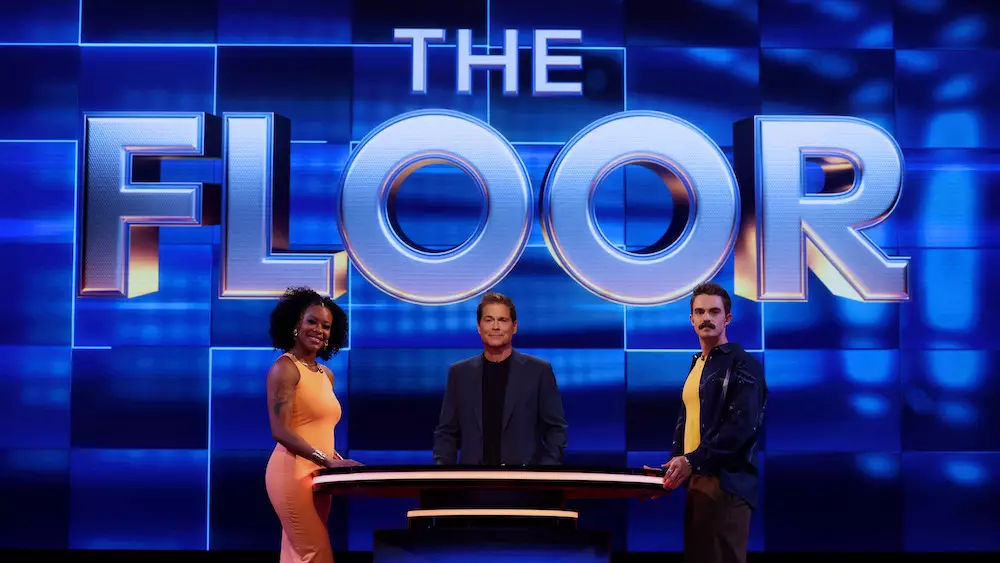The game show landscape has been undergoing a transformation in recent years, with various programs vying for viewers’ attention amidst a sea of entertainment options. One standout in this competitive environment is “The Floor,” a Rob Lowe-hosted game show that appears to defy the odds with its increasing popularity as it progresses into its second season. Recent Nielsen data indicates that the show has reached impressive heights, drawing in 2.2 million viewers in its latest episode, tying for the highest viewership since the season began. Such momentum speaks to the show’s ability to resonate with a diverse audience, making it a pivotal offering in network television.
What sets “The Floor” apart from many other contemporary shows is its capacity to attract a broad demographic spectrum. According to Lowe, an essential factor contributing to this rise in viewership is the strong trend of co-viewing among different age groups. In a modern media landscape where entertainment options are often segmented to fit specific audiences—resulting in siloed viewing behaviors—”The Floor” acts as a unifying force, pulling in family members of all generations to watch together. This characteristic is increasingly rare and therefore highlights the cultural significance of the show. In an era where viewers can curate their own content experience, a game show that promotes family interaction serves as a refreshing notion for both viewers and network executives.
The success of “The Floor” is not only reflected in live viewership but also extends to its delayed viewing figures. After seven days post-broadcast, the show ranks as the most-watched game show across both broadcast and cable platforms. Its premiere episode saw a remarkable 123% increase in audience size when accounting for multi-platform viewing, indicating that viewers are actively seeking it out beyond its original airing time. This trend speaks volumes about its content quality and viewer engagement, solidifying “The Floor” as a mainstay in the entertainment schedule.
Moreover, Lowe’s insights into the nature of game shows offer valuable context: unlike many serialized dramas or comedies, game shows, particularly competitive ones, present stakes that encourage immediate viewing. Audiences risk having the outcomes spoiled, motivating them to tune in live rather than watch later at their convenience. The combination of high engagement and real-time anticipation ensures that “The Floor” thrives in such an environment, solidifying its brand and enhancing its relevance on the network.
Rob Lowe is acutely aware of the complexity that comes with hosting a game show—he likens it to “being an air traffic controller while doing a one-man show.” This analogy encapsulates the multi-faceted responsibilities he bears, which extend beyond merely presenting. First-rate hosting requires quick thinking, charisma, and the ability to engage contestants and the audience alike. Lowe’s commitment to his role shines through in his acknowledgment of the demanding nature of the job. His enthusiasm for the challenge signifies a dedication that likely contributes to the show’s positive reception.
Furthermore, Lowe’s interaction with the audience is instrumental in creating a dynamic viewing experience. He blends humor, wit, and a genuine appreciation for the contestants, allowing viewers to feel invested in their journeys. The host’s performance is pivotal in sustaining the energy of the show and fostering community spirit, further enhancing the appeal of “The Floor.”
The strategic renewal of “The Floor” for both seasons two and three demonstrates Fox’s confidence in the show’s capabilities to capture and hold an audience. The decision to run these seasons concurrently, as noted by Lowe, turns each season effectively into one extended viewing experience. This approach not only caters to audience demand but also showcases a perceptive understanding of programming that nurtures growth. In contrast to previous practices where series were granted multiple seasons based on initial performance, the present-day focus is on sustained audience engagement over time.
As Lowe notes, there’s a reassurance in being entrusted with two seasons from the get-go, contrasting the often precarious nature of program renewals today. His proactive approach to developing new game shows—a creative endeavor that he embraces whole-heartedly—indicates that the tradition of game shows is evolving. With networks like Fox investing in versatile programming formats, the genre is poised for a renaissance.
“The Floor” embodies a compelling case study in modern television’s evolving landscape, illustrating the enduring appeal of game shows as family-friendly entertainment. With strong viewership metrics, engaging hosting, and strategic network decisions, the show is carving out a unique space in the industry. As it continues to grow alongside Rob Lowe’s creative aspirations, the future of “The Floor” and similar formats looks promising, solidifying their place in the hearts and homes of viewers across generations.

